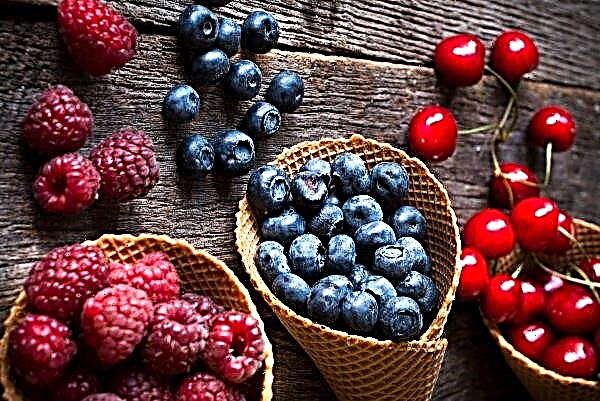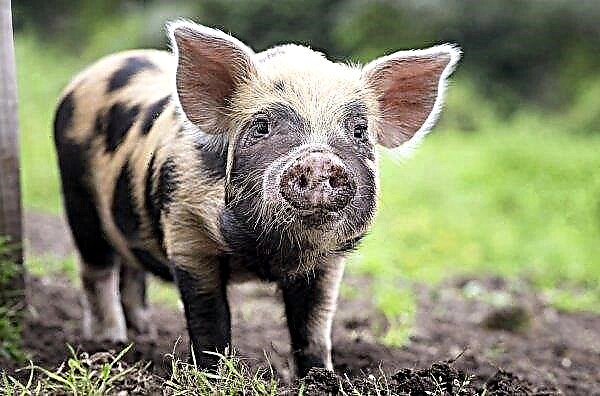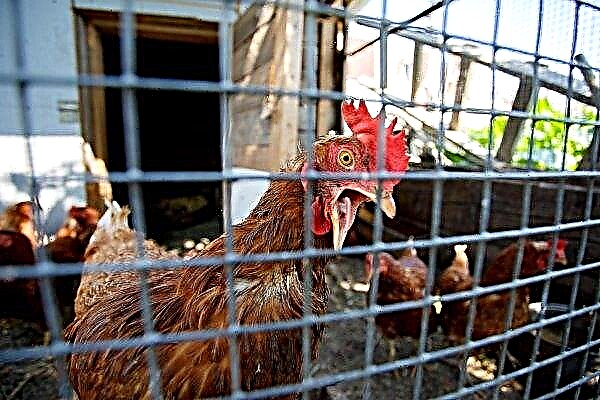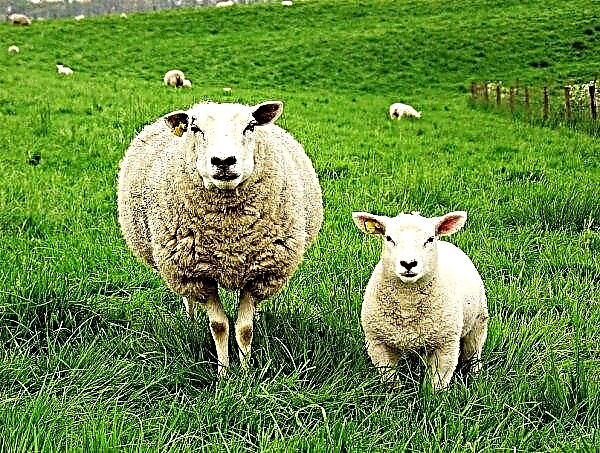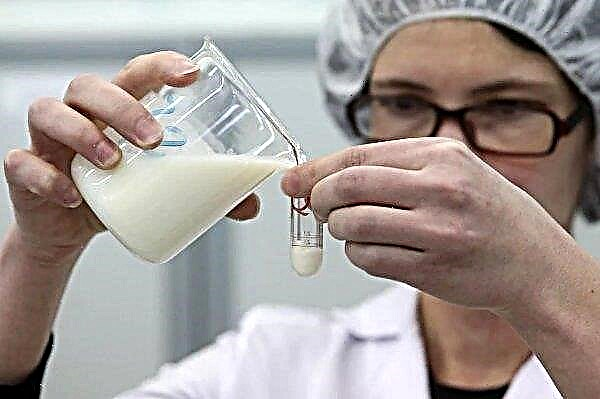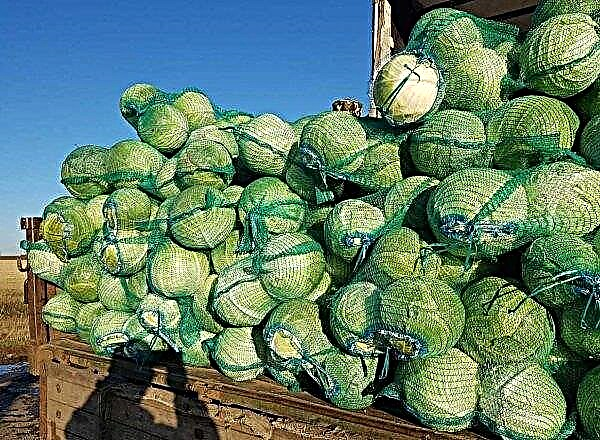The demand for cucumber among all vegetable crops is very high, since it is consumed almost all year round both in raw and salted form. That is why in almost every garden you can see a place for cucumber bushes, which receive a lot of attention. You can learn about the features of growing cucumbers in open ground on a trellis by reading this article.
Basic rules for growing cucumbers on a trellis
Before you begin to study the technology of cultivation, you should understand what constitutes a trellis. This is a design that acts as a support for plants that are curly by nature. The use of such a device involves replacing traditional horizontal cultivation with vertical.
The use of trellis has a number of advantages, which are the reason why it is so necessary at the farm site:
- creates additional space for growth, reducing the area of the garden on which cucumbers are grown;
- plant stems do not break, do not get trampled into the ground;
- stems and fruits have good access to sunlight and air flows, increased productivity of bushes;
- fruiting period is prolonged;
- the use of trellis support helps prevent the appearance of many diseases of vegetable crops, since the plant has limited access to the soil and is well ventilated in a natural way;
- convenient to care for the bush (pruning, garter, preventive treatment of the bush);
- comfortable harvesting conditions;
- serves as an element of landscape decoration, creating an aesthetic decoration with tied bushes of cucumbers.
Preparatory stage
Before installing the trellis, it is necessary to perform a number of preliminary works:
- create optimal conditions for growing;
- develop a scheme for planting cucumbers;
- prepare the soil and create beds;
- choose the type of trellis;
- install the design.
Did you know? There is a cucumber called dosakaya, which has a bright yellow color, a soft, slightly sweetish flavor and is characterized by a lack of smell. It is used in India and Sri Lanka in the preparation of Indian curries and stews.
Optimal conditions for growing cucumbers
The agricultural technology of cucumbers consists in observing certain conditions that contribute to the successful cultivation of this crop and high yields.
Lighting
Cucumbers need light, because its lack will affect the appearance of the bush:
- the shoots will rapidly stretch;
- leaves will lose color;
- flowering will come later and be sparse;
- the taste characteristics of the fruit will be of poor quality.

The amount of heat
For seed germination, the minimum soil temperature should be at least + 12 ° C. Before planting, you should make sure that the soil is sufficiently warmed up, and for this you can use either technical devices or pay attention to natural tips: flowering lilac and yellow acacia. With a lack of heat, this vegetable crop will not grow. For planting, it is better to highlight a site on the sunny side.
Moisture
There are periods when cucumbers need abundant watering, at the same time there are times when it is completely undesirable to water the bush. The period of active growth should be accompanied by abundant moisture in the soil, which will contribute to a good set of vegetative mass. However, do not over-fill the soil in order to prevent stagnation of water and not provoke rotting of the stem. When the first flower buds appear, watering is minimized, stimulating the development of flowering of female flowers. Over time, watering is gradually increased, reaching the maximum value at the time of the appearance of poured greens on the lashes.
Important! Gardeners planting cucumbers on a trellis for several years recommend staging in increments of 2 weeks, which significantly increases yield.
The water temperature for irrigation of cucumbers should be warm and should be +20 ... + 25 ° C. It is better to water in the evening, without falling on the foliage. Cucumbers absolutely need all of the above conditions, since the lack of at least one of them can significantly affect the development of the bush and the volume of the crop. In addition, before determining the place of landing, you must make sure that the place is sufficiently protected from strong gusts of wind. It is also worth mentioning the need for high-quality top dressing of the soil, which will be described in more detail below.
Cucumber predecessors
It is recommended to plant cucumbers in that section of the garden where such vegetables were previously grown:
- Tomatoes
- potatoes;
- cabbage;
- bow;
- pepper;
- legumes.

Soil preparation and beds
Pre-planting preparation must include:
- soil monitoring;
- soil cultivation;
- soil fertilizer.
Cucumbers are best planted in open ground, which has the following characteristics:
- loose;
- with good breathability;
- moisture-absorbing, able to absorb and retain moisture;
- well warmed by the rays of the sun, warm;
- without weeds;
- well-nourished by organic matter;
- neutral, with a slightly acid reaction.
Important! When harvesting high-quality, mature cucumbers, one should remember the need to remove damaged, non-standard, diseased fruits in order to prevent the bush from depletion and to prolong the fruiting period.
As an organic feed most often used:
- manure;
- mulch;
- solution from chicken droppings;
- mullein tincture;
- needles;
- complex mineral fertilizer.
To maintain friability, you can add to the soil:
- peat;
- sand;
- old sawdust;
- humus.

Selection and installation of trellises
First of all, it is necessary to develop a scheme for planting cucumbers in this garden plot, and after that it is already a decision to choose the material from which the trellis will be built.
It can be made from:
- wood, log cabins;
- gland;
- concrete pipes;
- steel;
- twine ropes;
- lattice.
As a rule, the height of the trellis is 2 m above the ground and 0.5 m deep into the soil. The installation procedure of the structure should be carried out carefully, without damaging the young shoots.
Important! It is necessary to start building the structure before the moment when the sprouts reach 10 cm in height, since then the plant will begin to lay on the ground and it will no longer be disturbed so as not to damage the fragile stems.
The process involves:
- Installation of the main supports, which are often used wooden sticks. They are dug to the above depth with an interval of 4 m.
- Pulling a rope, wire or nailed wooden horizontal rails, depending on the material chosen. The crossbeams should be quite strong so that they do not bend under the weight of the bushes with the crop.
- If you plan to use the trellis as a decorative element, then it can be made openwork, with patterns of metal or wooden elements.
 Demanded are:
Demanded are:Planting seeds
There are 2 ways to grow cucumbers on open ground:
- sowing seeds;
- planting seedlings.
- Selection of high-quality planting material. To do this, you can fill it with a 3% saline solution, in which good seeds will settle to the bottom of the tank, and unsuitable seeds will remain on the surface of the water.
- Treatment with a weak solution of potassium permanganate (1%), which will help kill possible infections.
- Soaking in a solution of wood ash for 6 hours.
- Rinse.
- Wrap with a wet cloth.
- Warming up in the sun on a windowsill.
As a result of these manipulations, the seeds become slightly swollen, ready for rapid germination. All varieties of cucumbers are suitable for planting in the open ground, you just have to carefully read the instructions on the bag with seeds, focusing on the desired taste characteristics, fruit size, yield and resistance to diseases and pests. It is worth paying attention to hybrid varieties that have a large number of positive characteristics, are resistant to many diseases and are easy to care for.
Do not lose sight of the timing of the ripening of the crop:
- early ripening;
- mid-season;
- late.
Sowing in open ground begins from mid-May to mid-June. During this period, the soil is already sufficiently warmed up and there is no possibility of frost return, the maximum duration of daylight hours is observed and high rates of air heating are recorded. All these factors contribute to the successful germination and rapid germination of seeds.
Further care for cucumbers
The care for planted cucumbers on the trellis in the future will be as follows:
- tying cucumber shoots;
- the formation of bushes and pinching;
- timely watering;
- nutritional supplementation.
Cucumber Garter
Tying cucumbers on the trellis ensures the correct formation and growth prospects of the bush. Gartering occurs as the bush grows by pulling up the ropes, rather than tightening the knots, for reliable support and fixing the bush in a certain position, so that it does not get injured. First, fix the very top of the stem and, as it grows, wrap it with another rope. Scourges that do not catch on the trellis on their own are tied up, directing their growth to free areas. In the process of tying, it is necessary to inspect the stem of the bush, removing dried and diseased leaves.
For garter use a material that should have the following characteristics:
- lasting;
- elastic;
- soft so as not to damage the stem.

Shaping and pinching
Caring for cucumbers includes the mandatory formation of a bush, so that the plant does not spend energy on growing unnecessary processes and ugly fruits.
Form a bush on a trellis as follows:
- The pinching of the central stem is carried out over the 5-6 leaf, as a result of which there is a more intensive development of the lateral shoots, on which the female flowers are formed. It is they that eventually transform into fruits.
- In this case, male flowering should be regularly removed.
- Stepsons and lateral processes from 3-4 sheets need to be cut.
Watering and fertilizing
Watering is very important for growing cucumbers both during the period of bush growth, and during the formation of the ovary and fruiting. If a temporary break occurs and the soil is not sufficiently moistened, this significantly affects the quality of the product as a result. The taste characteristics of the crop are changing, bitterness may appear. Pour cucumbers into the holes between the rows. It is best to water in the evening or early in the morning before the start of strong sunshine. For watering, you should use warm water with a temperature in the range + 18 ... + 25 ° C, since cold water can disrupt the growth of the bush and delay it somewhat. Cold watering can also provoke the appearance of a number of diseases, for example, gray rot. To retain moisture in the soil, it is recommended to use organic mulching. This method of surface shelter of the soil protects it from the rapid evaporation of moisture, prevents the growth of weeds, contributes to a longer preservation of its friability, supports soil aeration.
Cold watering can also provoke the appearance of a number of diseases, for example, gray rot. To retain moisture in the soil, it is recommended to use organic mulching. This method of surface shelter of the soil protects it from the rapid evaporation of moisture, prevents the growth of weeds, contributes to a longer preservation of its friability, supports soil aeration.
Did you know? To determine the lack of watering is possible not only by the condition of the soil, but also by the appearance of the leaves on the bush. If they are dark and fragile - there is little water for cucumbers, but a pale green color indicates an abundance of moisture.
You can fertilize cucumbers with such organic substances:
- compost;
- litter;
- manure.
To do this, they are mixed with other components, for example, with mullein or chicken droppings, combining with ash. It should be remembered that manure and litter are very active and can burn the roots of the bush. Therefore, having these fertilizers available, they should be used in diluted form, partially rotated. Compost fertilizers can provoke an excess of nitrates. Feeding should begin after the appearance of 2-3 sheets and continue until the end of fruiting with an interval of 2 weeks. Complex fertilizers can also be used for fertilizer.
Cucumbers need such substances as:
- nitrogen;
- phosphorus;
- potassium.

Harvest Features
The average ripening period of cucumbers is 40 days. Harvest time in many respects depends on the purposes of its further use:
- for the conservation of tiny cucumbers they are collected at the age of 2 days;
- to twist gherkins 5–9 cm long, they are torn off when they are 4–5 days old;
- for traditional fresh consumption, cucumbers are removed from the trellis after they reach 8-12 days, when their length is 10 cm or more.
The regularity of the harvest should be 2 days, since the delay in this process can lead to less intensive fruiting. To do this, it is better to arm with a knife and cut the necessary fruits. Plucking, pulling and twisting the stalks is extremely undesirable, as this weakens the bush. It is better to collect cucumbers in the morning or evening, when solar activity is not very strong. Harvest stacked in a cool place.
At the end of the harvest from the trellis, it is necessary to remove all residues of vegetation and destroy them, it is desirable to burn. This will help prevent the spread of possible diseases in the future. The net, twine or wire (what was used to support the stem on the trellis) is removed from the stakes. After which they are also removed from the soil and dried, stacked for winter storage in the utility room. After removing the trellis, you need to take care of the soil by digging and fluffing up the earth, removing the roots of the bushes from it. After that, you can start preparing the beds for growing the next crop: fertilize it with manure and mulch it.
Useful Tips
To get a high crop of quality fruits, experienced gardeners are advised to pay attention to the following recommendations:
- The seed selection process is very important. It is not recommended to use seeds that were recently harvested, as this will prevent the formation of female flowers, the amount of which depends on the amount of the crop. Planting material has a rather long germination period, which can reach 8–10 years, so you should carefully look for the deadline for selling seeds indicated on a paper bag in the store. As a rule, it is 2-3 years from the date of collection. It is better to choose those seeds whose age is more solid.
- The bush of cucumbers will please with good productivity if it is not overloaded and no more than 20 green leaves are left at a time.
- During flowering, insects that provide pollination can be attracted. To do this, apply a hot aqueous solution with the addition of sugar and boric acid.
- To increase the number of female flowers on the bush, it is recommended to stop watering for a while before flowering. This provokes a reaction of self-preservation, since the plant perceives this as a threat to its vital activity, and it begins to form fruits more intensively.
- An option for enhancing fruiting is the pollination of different varieties, subject to the close planting of different types of cucumbers.
- To obtain a larger crop, it is recommended to remove the first ovary. The plant in this case becomes stronger and forms more fruits.
Common mistakes gardeners
When growing cucumbers, many gardeners encounter problems that lead to poor fruit quality or reduced yield.
So, the absence of top dressing entails:
- discharge of ovaries;
- yellowing of leaves;
- deformation of the fruit.
If the cucumbers on the trellis have acquired a non-standard shape, this may be a signal:
- potassium deficiency - while the shape of the cucumber becomes pear-shaped;
- lack of nitrogen - this is evidenced by the narrow, lighter, bent tip of the cucumber;
- temperature fluctuations and cold watering - narrowing in the middle of the fetus, similar to the female waist, can “talk” about this;
- rare watering - cucumbers can grow curves, in the form of an arc.
 A lack of moisture can change the taste of a fresh product, adding a bitter note to it. Cultivation using trellis is a convenient and profitable way to get a good and high-quality crop of cucumbers. This method is simple to implement, in addition, it has a lot of advantages over the more traditional in our area - horizontal cultivation.
A lack of moisture can change the taste of a fresh product, adding a bitter note to it. Cultivation using trellis is a convenient and profitable way to get a good and high-quality crop of cucumbers. This method is simple to implement, in addition, it has a lot of advantages over the more traditional in our area - horizontal cultivation.

